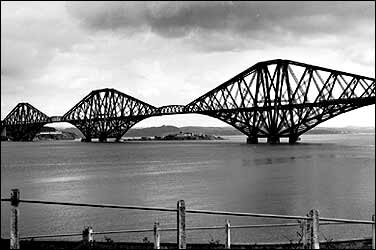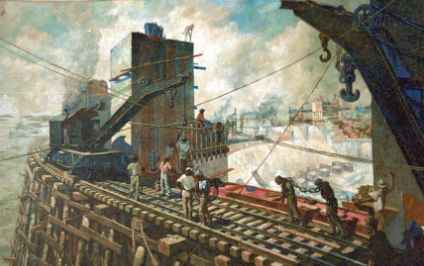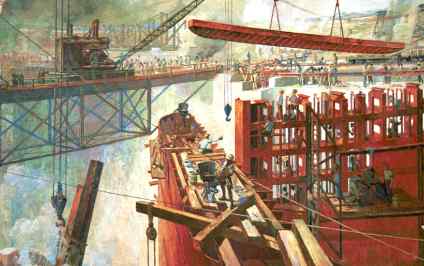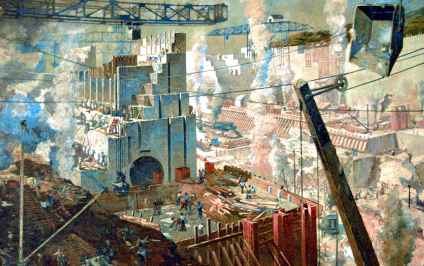Second Industrial Revolution
Second Industrial Revolution 1890-1940
The very late part of the 19th century, from 1890 to 1940, saw the "Second" Industrial Revolution emerge with a host of new emerging technologies.
|
The revolution started when German Chemistry extracted nitrogen from the atmosphere to make fertilizers and thereby increase crop yields. The chemical industry is born and grows to include the exploitation of fossil fuels as a source of energy through petroleum refining and distribution. The twentieth century saw the growth of the automotive industries through the internal combustion engine which sees an exponential growth in transportation by land (automobiles), sea (ocean going liners), and air. The revolution also created the electrical industry and brings electrical devices and telephones into the home. For the public the revolution was epitomized by mass production of consumer goods and the mechanization of manufacturing to serve the needs of an increasing population. There is a transition of technological leadership from United Kingdom to the United States and Germany. So many changes and innovations required an even more structured approach to business, management, and projects. In society the shifts of power continues to the industrial classes and /commercial business world. The state’s role is to run mega projects of national interest. The monarchy virtually has no role in these projects. One of the most significant, complex and challenging projects of this period was in Panama. The idea of connecting the Atlantic and Pacific Ocean through Central America dates back to the 16th century when a route was surveyed through Panama. It was situated in one of the most difficult and inhospitable climates on earth with a tropical terrain of mountains and hostile jungles. The U.S. was interested in getting the canal constructed. The business case was lucrative. The journey for a ship sailing from New York to San Francisco via the canal cut the travel distance to 9,500 km (6,000 miles), from the 24,000 km (14,700 miles) route around Cape Horn. The U.S. had been negotiating a treaty with the Columbian Government since 1855 granting the U.S. the exclusive rights and privileges to build a canal. But In 1880 two Frenchmen organized the Panama Canal Company and obtained a concession from the Columbian Government to the surprise of the U.S. Government. The success of the Suez Canal buoyed the French and they began construction of the Panama Canal immediately using the same project manager. The French project ran into a series problems from the outset, as it had not been carefully planned, and was only won because of Suez. It went through a series of disasters, that resulted in a horendous death toll in the project workforce. After the French had spent over 20 years on it and $260m, major corruption was uncovered at all level, and the project was shutdown in disgrace with the imprisonment of the project manager. For the U.S. the project was very strategic for economic, political, and military reasons. The political will was there as the importance of the canal drove the business justification. With U.S. backing, Panama seceded from Colombia in 1903 and signed a treaty for the construction of a canal and U.S. sovereignty over the Panama Canal Zone. The principal reasons for the French project failure were mismanagement of finances, corruption, poor initiation, lack or planning for the workforce and its welfare in a tropical climate, inadequate equipment, poor contracts, and a lack of good project management. The success of this project highlighted the U.S. prowess at delivering mega projects and was one of four U.S. mega projects in this period. |
|
Other Significant Projects in this EraThe growth in canals and railways drove the transportation revolution and the need for many new bridges and significantly longer spans. The first cast-iron bridge in 1776 became the catalyst for bridge projects around the world. These projects carried many risks primarily financial, teething problems associated with new technologies. When the Sunderland Bridge opened in 1796, the iron arch was 15 times lighter than an equivalent arch in stone, and its span of 236 feet. This spawned projects around the world. Through a relatively short period of time there was a clear evolution in scale and scope of bridges which culminated in the following cast iron, and wire and concrete structures. All these project were pushing the technologies of the time to the limit:
|
 |




